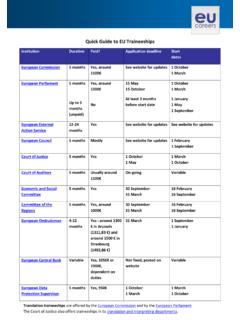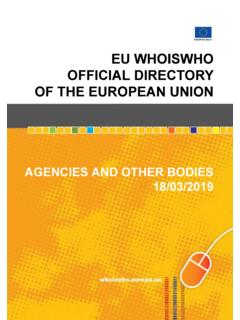Transcription of ESPAD Report 2015 - www.emcdda.europa.eu
1 ESPAD Report 2015 Results from the European School Survey Project on Alcohol and Other DrugsESPAD Report2015 Results from the European School Survey Project on Alcohol and Other DrugsThe ESPAD GroupESPAD Report2015 Results from the European School Survey Project on Alcohol and Other DrugsESPAD GroupLudwig Kraus, Ulf Guttormsson, H kan Leifman, Sharon Arpa, Sabrina Molinaro, Karin Monshouwer, Marcis Trapencieris, Julian Vicente, rs ll M r Arnarsson, Olga Balakireva, Elin K. Bye, Anina Chileva, Mihai Ciocanu, Luke Clancy, Ladislav Cs my, Tatijana Djurisic, Zsuzsanna Elekes, Fernanda Feij o, Silvia Florescu, Iva Pejnovi Franeli , Esther Kocsis, Anna Kokkevi, Patrick Lambrecht, Tanja Urdih Lazar, Alojz Nociar, Silvana Oncheva, Kirsimarja Raitasalo, Liudmila Rup ien , Janusz Sieros awski, Mette Vinther Skriver, Stanislas Spilka, Julian Strizek, Lela Sturua, Ervin To i, Kyriacos Veresies, Sigrid Vorobjov, P l Weihe, Andr Noor, Jo o Matias, Nicki-Nils Seitz, Daniela Piontek, Johan Svensson, Anna Englund and Bj rn HibellCoordinating CommitteeLudwig Kraus, H kan Leifman and Julian VicenteSteering CommitteeSharon Arpa, Ludwig Kraus, H kan Leifman, Sabrina Molinaro, Karin Monshouwer.
2 Marcis Trapencieris and Julian VicenteLegal noticeThis publication of the European Monitoring Centre for Drugs and Drug Addiction ( emcdda ) and the European School Survey Project on Alcohol and Other Drugs ( ESPAD ) is protected by copyright. The emcdda and ESPAD accept no responsibility or liability for any consequences arising from the use of the data contained in this document. The contents of this publication do not necessarily reflect the official opinions of the partners of the emcdda and ESPAD , any European Union Member State or any institution, agency or other body of the European Direct is a service to help you find answers to your questions about the European number (*): 00 800 6 7 8 9 10 11(*) The information given is free, as are most calls (though some operators, phone boxes or hotels may charge you).
3 More information on the European Union is available on the internet ( ).Luxembourg: Publications Office of the European Union, 2016 Print ISBN 978-92-9168-918-7 doi: ISBN 978-92-9168-919-4 doi: ISBN 978-92-9168-917-0 doi: ISBN 978-92-9168-920-0 doi: European Monitoring Centre on Drugs and Drug Addiction, 2016 European School Survey Project on Alcohol and Other Drugs, 2016 Reproduction is authorised provided the source is acknowledged. Credits for photos: in LuxembourgPrinted on elemental chlorine-free bleached paper (ECF)Pra a europa 1, Cais do Sodr , 1249-289 Lisbon, PortugalTel. +351 I I ESPAD Report 2015 3 Preface ..7 List of authors ..9 Summary ..11 Introduction ..17 Background to ESPAD ..18 ESPAD Report 2015 ..20 Methodology ..21 ESPAD 2015 ..22 Trend analyses ..26 Reporting ..27 The situation in 2015 .
4 29 Availability of substances ..30 Early onset of substance use ..33 Cigarette use ..36 Alcohol use ..37 Illicit drug use ..39 Inhalant use ..42 New psychoactive substance use ..43 Conditional probabilities of substance use ..44 Patterns of current use ..46 Internet use, gaming and gambling ..64 Trends 1995- 2015 ..69 Trends across 25 countries ..70 Country-specific trends ..76 Discussion and conclusion ..83 Cigarette use ..84 Alcohol use ..85 Illicit drug use ..86 Internet use, gaming and gambling ..87 Limitations ..89 Conclusion ..89 Acknowledgements ..91 References ..95 Contents4 ESPAD Report 2015 Table 1. Overview of countries participating in ESPAD . 1995- 2015 19 Table 2. Sampling characteristics of ESPAD 2015 24 Table 3a. Perceived availability of substances: prevalence of students responding substance fairly easy or very easy to obtain (percentage) 31 Table 3b.
5 Perceived availability of substances: prevalence of students responding substance fairly easy or very easy to obtain (percentage) 32 Table 4a. Early onset of substance use: prevalence of students experiencing substance use (cigarettes, daily smoking, alcohol, intoxication) at the age of 13 or younger (percentage) 34 Table 4b. Early onset of substance use: prevalence of students experiencing substance use (cannabis, ecstasy, amphetamine/methamphetamine, cocaine/crack) at the age of 13 or younger (percentage) 35 Table 5. Cigarette use: prevalence of lifetime and 30-day use (percentage) 36 Table 6. Alcohol use: prevalence of lifetime use, 30-day use and intoxication (percentage) 38 Table 7a.
6 Illicit drug use: lifetime prevalence of the use of any drug, cannabis, ecstasy, amphetamine and methamphetamine (percentage) 40 Table 7b. Illicit drug use: lifetime prevalence of the use of cocaine, crack, LSD or other hallucinogens, heroin and GHB (percentage) 41 Table 8. Inhalants and new psychoactive substances (NPS): prevalence of lifetime use (percentage) 42 Table 9. Pharmaceuticals: lifetime prevalence of the use of painkillers to get high, tranquillisers or sedatives without prescription and anabolic steroids (percentage) 44 Table 10. Prevalence of lifetime use of substance B conditional on the lifetime use of substance A (percentage) and number of users of substance A (n) 45 Table 11a.
7 Average number of days on the internet (mean number of days) and prevalence of internet activities on 4 or more days in the last 7 days (percentage) 65 Table 11b. Prevalence of internet activities on 4 or more days in the last 7 days by gender (percentage) 66 Table 12. Gambling for money: prevalence in the last 12 months (percentage) 67 Table 13. Overview of ESPAD surveys conducted between 1995 and 2015 by country: sample size and participation rate 71 Table 14. ESPAD average for selected indicators based on 25 countries: 1995- 2015 72 Figure 1a. Daily cigarette use: prevalence in the last 30 days (percentage) 46 Figure 1b. Daily cigarette use: prevalence in the last 30 days by gender (percentage) 47 Figure 2a.
8 Frequency of alcohol intake in the last 30 days (mean number of occasions among users) 48 Figure 2b. Frequency of alcohol intake in the last 30 days by gender (mean number of occasions among users) 49 Figure 3a. Average alcohol intake on the last drinking day in centilitres of ethanol among users 50 Figure 3b. Average alcohol intake on the last drinking day in centilitres of ethanol among users by gender 51 Figure 4a. Preferences of alcoholic beverages on the last drinking day; proportion of alcohol volume in centilitres of ethanol for each beverage on total consumption 53 TablesFiguresESPAD Report 2015 5 Figure 4b.
9 Preferences of alcoholic beverages on the last drinking day by gender; proportion of alcohol volume in centilitres of ethanol for each beverage on total consumption 53 Figure 5a. Prevalence of five or more drinks at least once in the last 30 days; one drink contains approximately 2 centilitres of ethanol (percentage) 54 Figure 5b. Prevalence of five or more drinks at least once in the last 30 days by gender; one drink contains approximately 2 centilitres of ethanol (percentage) 55 Figure 6a. Prevalence of cannabis use in the last 30 days (percentage) 56 Figure 6b. Prevalence of cannabis use in the last 30 days by gender (percentage) 57 Figure 7a. Frequency of cannabis use in the last 12 months (mean number of occasions among users) 58 Figure 7b.
10 Frequency of cannabis use in the last 12 months by gender (mean number of occasions among users) 59 Figure 8a. Prevalence of inhalant use in the last 30 days (percentage) 60 Figure 8b. Prevalence of inhalant use in the last 30 days by gender (percentage) 61 Figure 9a. Prevalence of new psychoactive substance use in the last 12 months (percentage) 62 Figure 9b. Prevalence of new psychoactive substance use in the last 12 months by gender (percentage) 63 Figure 10. Countries included in the 25-country average (marked in blue) 70 Figure 11. Perceived availability of cannabis by gender; students responding cannabis fairly easy or very easy to obtain: 25-country trend 1995- 2015 (percentage) 73 Figure 12.



